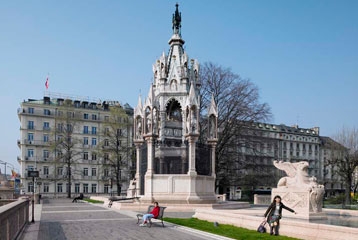Discover a selection of the curiosities in the Pâquis Sécheron district, many of them steeped in history.
The Bains des Pâquis
The Bains des Pâquis have been part of the district’s history since 1872. Initially private, they were called the “Bains Henri” after their owner. In 1889, they became municipal baths and a lighthouse was built there in 1911. They were then completely rebuilt in 1931. Threatened with destruction in 1988, they were saved by means of a citizens’ initiative.
Today, whether you want to enjoy the fondue, the sun or the sauna, the Bains des Pâquis are a firm favourite with the inhabitants of Geneva who go their en masse, summer and winter alike. An advertisement from 1952 vaunts the benefits of “Pâquis-Plage, the official establishment of the City of Geneva. Water, fresh air and sun”.
«Broken chair» on the Place des Nations
At the heart of international Geneva, the Place des Nations offers the citizens of the world a platform to speak to the general public and diplomats alike. It is here that the monumental “Broken chair”, created by local artist Daniel Berset, can be seen. Amputated of part of its fourth leg, this chair symbolises the fight against anti-personnel mines.
Trees bearing witness to history
Metasequoias, living fossils
Genuine living fossils, metasequoias have been around for more than 200 million years. In 1943, the discovery of a few living examples of this conifer – previously thought extinct – in China created quite a stir. Noting that the tree was endangered, the Arnold Arboretum in Boston distributed seeds collected during an expedition to China to a number of botanical gardens. Some of them were planted in Geneva in 1948. Today, visitors to the Botanical Garden can admire three specimens of this tree which was already on Earth at the time of the dinosaurs!
The plane trees in the Botanical Gardens: 300 year-old giants
The lane of plane trees in the Botanical Gardens is home to some of the oldest trees in the canton. These specimens are estimated to be some 300 years old. They already appeared on a plan dating back to 1728, filed in the archives of the canton’s land registry. From the very tops of these giants (the tallest reaches a height of 37 metres with a circumference of 4.5 metres), they have seen great changes to the district. Among other things, they have witnessed the arrival of the railway, the construction of the Route Suisse and the creation of the UN.
The Brunswick monument
A linguist, horseman and musician, Charles d’Este-Guelph, Duke of Brunswick, was also a true original and paranoid to boot. In 1830, a revolt caused him to flee his duchy, situated in modern-day Germany. He initially travelled to Paris, where he made his fortune, before moving to Geneva in 1870.
On his death in 1873, the Duke left no heir. He therefore decided to bequeath his considerable fortune to the City of Geneva in exchange for a sumptuous funeral and a monument bearing his name. No mausoleum had ever been built in Geneva at this time. The building of the Brunswick monument in the Jardin des Alpes in 1879 was thus a much-debated affair. As stipulated by the Duke in his testament, the monument emulated the tomb of the Scaligeri family in Verona, Italy, which was erected in the 14th century. Some 14 years later, the equestrian statue at the top of the building began to sway. It was taken down and placed on the esplanade.
Some works, monuments and tourist sites in Pâquis Sécheron
Article modifié le 08.04.2024 à 13:47






